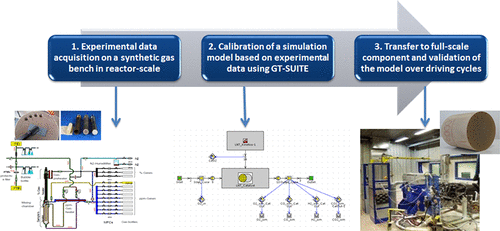当前位置:
X-MOL 学术
›
Ind. Eng. Chem. Res.
›
论文详情
Our official English website, www.x-mol.net, welcomes your
feedback! (Note: you will need to create a separate account there.)
Modeling NOx Storage and Reduction for a Diesel Automotive Catalyst Based on Synthetic Gas Bench Experiments
Industrial & Engineering Chemistry Research ( IF 3.8 ) Pub Date : 2018-08-30 , DOI: 10.1021/acs.iecr.8b01813 Federico Millo 1 , Mahsa Rafigh 1 , Francesco Sapio 1 , Syed Wahiduzzaman 2 , Ryan Dudgeon 2 , Paolo Ferreri 3 , Eduardo Barrientos 3
Industrial & Engineering Chemistry Research ( IF 3.8 ) Pub Date : 2018-08-30 , DOI: 10.1021/acs.iecr.8b01813 Federico Millo 1 , Mahsa Rafigh 1 , Francesco Sapio 1 , Syed Wahiduzzaman 2 , Ryan Dudgeon 2 , Paolo Ferreri 3 , Eduardo Barrientos 3
Affiliation

|
To comply with stringent NOx emission regulations, automotive diesel engines require advanced aftertreatment catalytic systems, such as lean NOx traps (LNTs). Considering that test bench and chassis dyno experimental campaigns are costly and require a vast use of resources for the generation of data; therefore, reliable and computationally efficient simulation models are essential in order to identify the most promising technology mix to satisfy emission regulations. In the literature, a large number of simulation models for LNT kinetics can be found, realized for laboratory-scale samples and validated over synthetic gas bench (SGB) experimental tests, while full-size models validated over engine-dyno driving cycle data, crucial for industrial applications, are missing. In the current work, a simulation model of an LNT device is built to predict NOx storage and reduction, starting from SGB laboratory tests and finally validated over driving cycle data. The experiments including light-off, NOx storage and reduction (NSR), and oxygen storage capacity (OSC) characterization, were performed on a laboratory-scale sample extracted from a full-scale monolith. Light-off tests have been conducted under a temperature ramp cycle from 120 °C to 380 °C, while OSC and NSR tests were performed under isothermal conditions at five temperature levels, ranging from 150 °C to 400 °C. OSC tests were performed to characterize oxygen storage capacity of ceria sites and water gas shift (WGS) reaction over the precious metals by controlling inlet species concentrations with periodic lean/rich pulses. NSR experiments were then performed by alternating a lean inlet composition to reproduce adsorption/desorption of NOx with a rich inlet composition feed with three reductants (H2, CO, and C3H6) to replicate NOx reduction reactions. A global kinetic scheme was defined by means of a one-dimensional (1D) engine simulation fluid-dynamic code, GT-SUITE, to model oxidation reactions (CO, HC, NO), NOx adsorption/desorption, oxygen storage and NOx reduction reactions. The kinetic parameters were obtained using Arrhenius plots with the aim to minimize the error between simulated and experimental NOx, reductants, N2O and NH3 concentrations, reaching a satisfactory agreement with measurements.
中文翻译:

基于合成气实验的柴油车催化剂氮氧化物存储和还原模型
为了符合严格的NO X的排放法规,汽车柴油发动机需要先进的后处理催化体系,如瘦NO X陷阱(LNT)。考虑到试验台和底盘测功实验活动成本高昂,并且需要大量使用资源来生成数据;因此,为了确定最有前途的技术组合以满足排放法规,可靠且计算效率高的仿真模型必不可少。在文献中,可以找到大量的LNT动力学模拟模型,可以用于实验室规模的样品,并通过合成气实验台(SGB)实验测试进行了验证,而大型模型则通过发动机动力驱动的驾驶循环数据进行了验证,这一点至关重要用于工业应用,则不见了。在当前工作中,建立了LNT设备的仿真模型来预测NO x存储和减少,从SGB实验室测试开始,最后经过驾驶周期数据验证。实验包括起燃,NO x储存和还原(NSR)和氧存储容量(OSC)表征是在实验室规模的样品中进行的,该样品是从全尺寸整料中提取的。起燃测试是在120°C至380°C的温度上升周期下进行的,而OSC和NSR测试是在等温条件下,在150°C至400°C的五个温度水平下进行的。通过使用周期性的稀/富脉冲控制进口物质的浓度,进行了OSC测试以表征二氧化铈位点的储氧能力和贵金属上的水煤气变换(WGS)反应。NSR实验然后通过交替贫入口组成重现吸附执行/ NO的解吸X具有丰富的入口组成进料具有三个还原剂(H 2,CO,和C3 H 6)复制NO x还原反应。通过一维(1D)发动机模拟流体动力学代码GT-SUITE定义了全局动力学方案,以模拟氧化反应(CO,HC,NO),NO x吸附/解吸,储氧和NO x还原反应。使用Arrhenius图,目的是最大限度地减少模拟和实验NO之间的误差,获得的动力学参数X,还原剂,N 2 O和NH 3倍的浓度,达到与测量令人满意的协议。
更新日期:2018-08-31
中文翻译:

基于合成气实验的柴油车催化剂氮氧化物存储和还原模型
为了符合严格的NO X的排放法规,汽车柴油发动机需要先进的后处理催化体系,如瘦NO X陷阱(LNT)。考虑到试验台和底盘测功实验活动成本高昂,并且需要大量使用资源来生成数据;因此,为了确定最有前途的技术组合以满足排放法规,可靠且计算效率高的仿真模型必不可少。在文献中,可以找到大量的LNT动力学模拟模型,可以用于实验室规模的样品,并通过合成气实验台(SGB)实验测试进行了验证,而大型模型则通过发动机动力驱动的驾驶循环数据进行了验证,这一点至关重要用于工业应用,则不见了。在当前工作中,建立了LNT设备的仿真模型来预测NO x存储和减少,从SGB实验室测试开始,最后经过驾驶周期数据验证。实验包括起燃,NO x储存和还原(NSR)和氧存储容量(OSC)表征是在实验室规模的样品中进行的,该样品是从全尺寸整料中提取的。起燃测试是在120°C至380°C的温度上升周期下进行的,而OSC和NSR测试是在等温条件下,在150°C至400°C的五个温度水平下进行的。通过使用周期性的稀/富脉冲控制进口物质的浓度,进行了OSC测试以表征二氧化铈位点的储氧能力和贵金属上的水煤气变换(WGS)反应。NSR实验然后通过交替贫入口组成重现吸附执行/ NO的解吸X具有丰富的入口组成进料具有三个还原剂(H 2,CO,和C3 H 6)复制NO x还原反应。通过一维(1D)发动机模拟流体动力学代码GT-SUITE定义了全局动力学方案,以模拟氧化反应(CO,HC,NO),NO x吸附/解吸,储氧和NO x还原反应。使用Arrhenius图,目的是最大限度地减少模拟和实验NO之间的误差,获得的动力学参数X,还原剂,N 2 O和NH 3倍的浓度,达到与测量令人满意的协议。











































 京公网安备 11010802027423号
京公网安备 11010802027423号